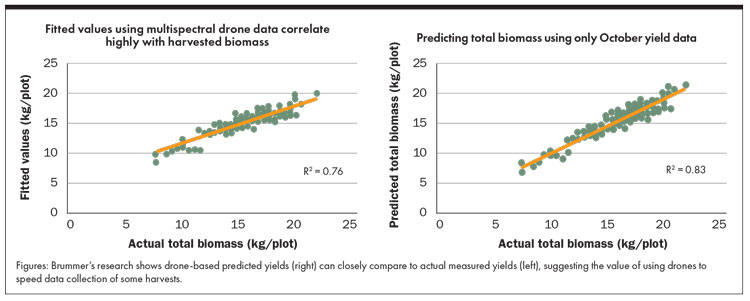
The use of genomic and phenomic technologies in alfalfa breeding programs could help enhance alfalfa yield, said Charlie Brummer, Center of Plant Breeding Director at the University of California (UC)-Davis.

Genetic markers, genomic predictions, drone-based sensors, and different statistical tools were used in his work to maximize alfalfa yield, funded by the Alfalfa Checkoff. Genetic markers were used to screen plants “so we could see which ones were the best at making great progeny (half-sib families), then cross them for a better estimate or idea of what’s going to be a good, high-yielding cultivar,” Brummer said.
He experimented with 200 half-sib families from UC-Davis breeding populations in 2017, 2018, 2019, and 2020, each year evaluating them for vigor and yield. By 2021, individual plants and half-sib families were identified with high biomass yield to produce experimental cultivars.
“We’ve made progress. We know all the steps of the process, and we’ve applied them all to our current breeding,” Brummer said. “Now it’s a matter of producing seed to document the changes that we think happened, and seeing the gain that we think we’ve made in terms of yield.”
This summer, plants are being intercrossed, then evaluated in the next year under full and deficit irrigation and saline and nonsaline irrigation. “It will still take a couple of years after we get the seed of populations until we get trial results,” Brummer pointed out. “Everything looks favorable that we are able to improve yield, and that these technologies can be applied to commercial breeding programs. But it’s going to be incremental yield gains; it’s not going to be an immediate 10% jump,” he added.

Saving time and money
Brummer hopes the research will also help speed up the alfalfa breeding process. He explained, “We used a whole suite of technologies, including genetic markers for whole genome analysis to predict yield and drones to estimate yields remotely rather than having to harvest plots, plus better statistical techniques to analyze data more robustly.”
Drones worked well in collecting data. “The time savings and money savings in flying drones rather than harvesting hundreds and hundreds of plots is fantastic,” Brummer said. The challenge is figuring out how to process the data in a streamlined way.

“We need to better understand how the plant grows and how we could potentially modify it and think about modifications that could lead to higher yield,” Brummer said. “With drones or other types of sensors where you could possibly get real-time data all day long, what does that tell us? Could we use all those data to potentially change our evaluations and our selections from what we do now? That’s a challenge,” he asserted.
Another challenge is the crop itself, Brummer noted. “Working on a perennial crop takes time; it’s hard to do experiments on a yearly basis or even over a couple of years. It takes time to do experiments in breeding, develop new populations, then test them, so things don’t move as fast as any of us would like,” he said.
Brummer also pointed out that this research wouldn’t exist without grower checkoff funding, “It’s hugely important to those of us in the public sector to have that source of funding.”

This article appeared in the August/September 2023 issue of Hay & Forage Grower on pages 20-21.
Not a subscriber? Click to get the print magazine.

